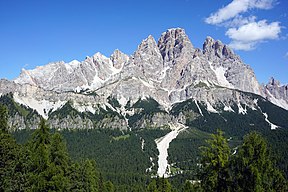Cristallo (mountain)
Mountain range in the Dolomites From Wikipedia, the free encyclopedia
Mountain range in the Dolomites From Wikipedia, the free encyclopedia
Cristallo (Italian pronunciation: [kriˈstallo]) (German: Kristallspitze) is a mountain massif in the Italian Dolomites, northeast of Cortina d'Ampezzo, in the province of Belluno, Veneto, northern Italy. It is a long, indented ridge with four summits higher than 3,000 metres. The mountain range is part of the Ampezzo Dolomites Natural Park.[2]
| Cristallo | |
|---|---|
 Cristallo, south side | |
| Highest point | |
| Elevation | 3,221 m (10,568 ft) |
| Prominence | 1,416 m (4,646 ft)[1] |
| Listing | Alpine mountains above 3000 m |
| Coordinates | 46°35′N 12°11′E |
| Geography | |
| Location | Belluno, Italy |
| Parent range | Dolomites |
| Climbing | |
| First ascent | 1865 (Monte Cristallo – Paul Grohmann, Angelo Dimai, Santo Siorpaes) |
In the north of the Cristallo group is the 1,530 m high mountain pass "Cimabanche" (in German: "Im Gemärk" also "Gemärk Pass", in Ladin: "Sorabances"), in the south the mountain pass Tre Croci (1,809 m, in Ladin: "Son Zuógo").
The highest peaks of the Cristallo massif are Monte Cristallo (3,221 m), Cima di Mezzo (3,154 m), Piz Popena (3,152 m) and Cristallino d'Ampezzo (3,008 m). Cima di Mezzo and Cristallino d'Ampezzo can be reached by via ferratas, while Monte Cristallo and Piz Popena both require climbing skills.
Cristallo is largely formed from the Upper Triassic dolomitic rock Dolomia principale. The mountain was formed during Cretaceous, as well as the rest of the Dolomites, due to the collision between the African and European continents.
A cable lift system starts from Rio Gere in Val Begontina, first a lift to Rifugio Son Forca at the upper end of Val Padeon. The gondola lift up to Forcella Staunies (2,919 m), close to Rifugio G. Lorenzi (2,932 m), was built for the Winter Olympics in Cortina in 1956. Both the lift and the refuge closed in summer 2016 due to "technical and administrative problems".[9]
The Dolomite Highway number 3 goes through the eastern part of the massif.

The two via ferratas VF Ivano Dibona and VF Marino Bianchi both start from the top of the cable car at Forcella Staunies. VF Marino Bianchi can be followed to the peak Cima di Mezzo.[10]
VF Ivano Dibona follows the Zurlon-ridge. It is a historical route used in World War I, and later restored and made safe for tourists.[11][12] At the beginning is the longest via ferrata suspension bridge in the Dolomites, the 27-metre-long Ponte Cristallo.[10][12]
The via ferrata VF Renato de Pol can be used for access from the western side of the Cristallo massif.[10]
Cristallo is one of the major skiing areas in the surroundings of Cortina. The former Staunis Verticale slope is one of the steepest in the Alps. There are numerous freeride ski routes on Monte Cristallo. The very steep gullies of the Forcella Staunis are known.[13] To the east of Monte Cristallo there is a small ski area at Lake Misurina.
Some of the cabins and restaurants available are the Rifugio Son Forca at 2,235 m; Capanna Guido Lorenzi at 3,003 m (Auronzo di Cadore); Ristorante Rio Gere at 1,680 m; Ristorante Lago Scin at 1,336 m; Ristorante Staulin at 1,370 m; Ristorante Son Zuogo at 1,800 m.
During World War I there was considerable military activity in the mountain. The front lines between Italian and Austro-Hungarian troops went through the mountains. Remains of ladders and barracks are still found today, and transport lines (ferratas) have been restored. At the passes Cimabanche and Tre Croci there are Italian bunkers from the time of World War II.
In 1993 the film Cliffhanger was shot on and around the bridge on the Zurlon-ridge, as well as some of the other peaks in the area. The mountain film The Blue Light from 1932 revolves around Monte Cristallo.
A legend narrates that on Monte Cristallo lived a beautiful princess who had many suitors, whom she always turned down.[14]
Seamless Wikipedia browsing. On steroids.
Every time you click a link to Wikipedia, Wiktionary or Wikiquote in your browser's search results, it will show the modern Wikiwand interface.
Wikiwand extension is a five stars, simple, with minimum permission required to keep your browsing private, safe and transparent.